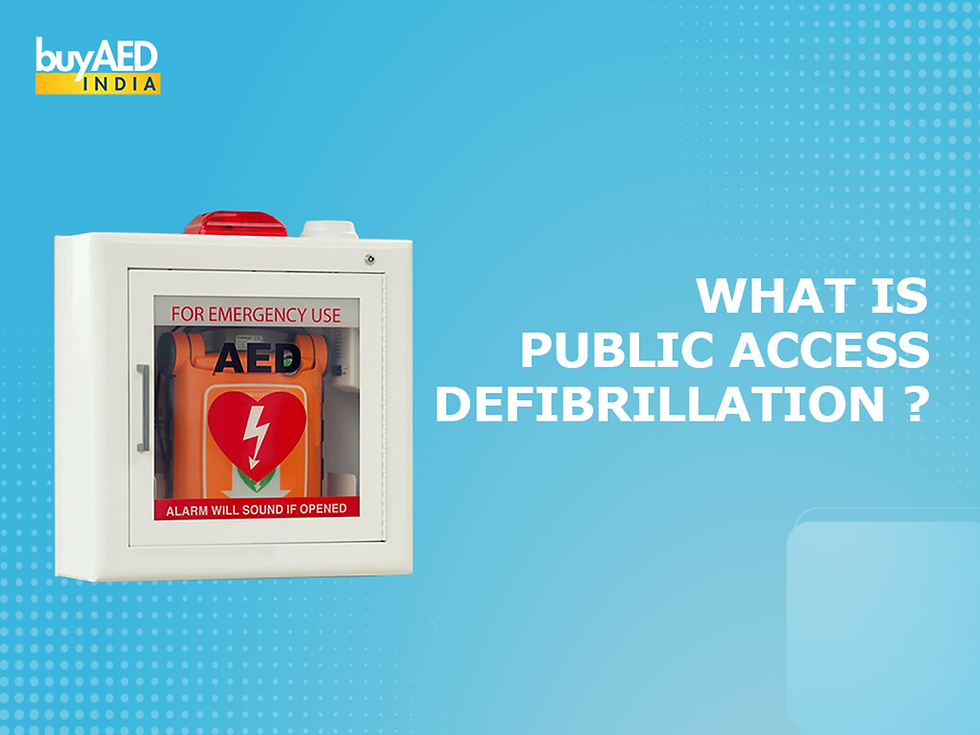Everything You Need to Know About Philips Defibrillators (AEDs)
- Dr. Shruti Shah

- Jun 16
- 5 min read

Sudden cardiac arrest (SCA) can strike anywhere, at any time and to anyone, without warning. Every second counts when such situations arise.
Quick access to an Automated External Defibrillator (AED) can dramatically increases the chances of survival.
Philips AEDs are widely recognized as among the premier AED brands worldwide due to their reliability, ease of use and advanced technology features.
If you're looking for a high-quality Philips AED in India, BuyAEDIndia offers a wide range of options for homes, workplaces, hospitals, and public places.
This blog provides an in-depth guide on Philips AEDs, covering features, benefits, types, usage tips and purchasing advice.
What is a Philips Automated External Defibrillator (AED)?
Philips Automated External Defibrillators (AEDs) are lifesaving medical devices designed to deliver an electric shock in case of sudden cardiac arrest.
Restoring normal heart rhythm requires monitoring heart activity and administering shocks only when necessary.
The app provides assistance by performing this analysis and administering shocks only as necessary.
Philips AEDs are widely acclaimed devices due to their user-friendly designs, innovative technologies, and proven effectiveness in emergency situations. These devices can often be found in:
Offices and workplaces
Airports, malls, and public places
Schools and universities
Hospitals and clinics
Gyms and sports facilities
Homes (for individuals at high risk of cardiac arrest)
Why are Philips AEDs important?

Philips AEDs play a vital role in improving survival chances during cardiac arrest situations, increasing survival chances by providing early cardiac intervention.
Without immediate CPR and defibrillation, survival rates decrease by 10% every minute.
Here’s why Philips AEDs are important:
Fast and Easy to Use: Designed for both trained and untrained users alike, our product makes work simpler than ever.
Quick Shock Delivery: Minimizing time between CPR and defibrillation, quickly administering shock.
Clear Voice Instructions: Provides step-by-step guidance.
Reliable and Accurate: Analyses heart rhythm and only delivers shock when necessary.
Compact and Portable: Our compact and portable devices make it simple for you to carry and store them wherever they may be used.
Trusted Brand: Used worldwide by medical professionals and first responders.
Philips AEDs make life-saving lifesaving possible for everyone - not only healthcare providers.
Types of Philips AEDs

Philips offers various AED models designed to meet different settings and needs. Here are the most widely used ones:
Best for homes, offices and public places
Easy-to-use design with voice instructions provides user with intuitive experience.
Pre-installed electrode pads ensure quick response time.
Lightweight and portable, ideal for first responders, businesses, and nonmedical personnel.
Best for: First-time responders, businesses, and non-medical personnel.
Designed for harsh environments (waterproof and rugged)
Infant/child key for pediatric use (no need to change pads)
SMART Analysis technology for accurate shock delivery
Military-grade durability
Best for: Schools, sports facilities, construction sites, and outdoor areas.
3. Philips HeartStart FR3 AED
Advanced features for professional responders
Faster shock delivery with minimal interruption to CPR
Tough and compact design for emergency situations
ECG display and additional accessories available
Best for: Hospitals, ambulances, first responders, and medical professionals.
Key Features of Philips AEDs
Philips AEDs are designed with advanced technology to ensure efficient and accurate defibrillation.
Here are some key features that make them stand out:
1. Smart Analysis Technology
Philips AEDs automatically analyze the heart’s rhythm and decide whether a shock is needed. This prevents unnecessary shocks and ensures safe usage.
2. Clear Voice Guidance
Each Philips AED provides step-by-step voice instructions, guiding users through the process of CPR and defibrillation. Some models even have adaptive volume control to adjust to noisy environments.
3. Quick Shock Feature
Philips AEDs deliver a shock within 8 seconds after CPR, reducing delays and improving survival chances.
4. Pediatric Mode (Infant/Child Key)
The Philips FRx AED includes a special Infant/Child Key, which automatically adjusts the shock level for pediatric patients without changing electrode pads.
5. Durable and Portable Design
HeartStart HS1 – Compact and lightweight
HeartStart FRx – Rugged, water-resistant, and dustproof
HeartStart FR3 – Tough, compact, and designed for emergency professionals
6. Long Battery Life
Philips AEDs feature long-lasting batteries that can handle multiple shocks and last for 4-5 years in standby mode.
7. Self-Testing and Maintenance Alerts
Philips AEDs automatically perform daily, weekly, and monthly self-checks to ensure they’re always ready for use.
Learn More: How much does a Defibrillator cost? (India)
How to Use a Philips AED?

Using a Philips AED is simple, thanks to its intuitive design and clear instructions. Here’s how you can use it in an emergency:
Step 1: Turn On the AED
Press the power button to activate the device. The AED will start giving voice instructions immediately.
Step 2: Attach Electrode Pads
Open the electrode pad case.
Place the pads on the bare chest as shown in the diagram (one on the upper right and one on the lower left).
Step 3: Let the AED Analyze the Heart Rhythm
The AED will automatically check if a shock is needed.
Step 4: Deliver the Shock (If advised)
If a shock is required, the AED will instruct you to press the shock button.
Some models (like the FR3) deliver the shock automatically.
Step 5: Perform CPR
After the shock, the AED will guide you to start chest compressions and rescue breaths until medical help arrives.
How to Choose the Right Philips AED in India?
1. Consider Where It Will Be Used
Home or Office: Philips HeartStart HS1
Schools, Gyms, Public Places: Philips HeartStart FRx
Hospitals, Emergency Responders: Philips HeartStart FR3
2. Check for Pediatric Support
If you need an AED for children, choose the Philips FRx AED with an Infant/Child Key for safe defibrillation.
3. Look for Durability
For outdoor or rugged environments, pick an AED with water and dust resistance, like the Philips FRx or FR3.
4. Ease of Use
If you're not a medical professional, opt for a simple, easy-to-use model like the Philips HS1 with clear voice instructions.
5. Battery and Maintenance Requirements
Ensure the battery life is long and the AED has self-testing features for maintenance alerts.
Learn More: Defibrillator Parts and Functions
Maintenance and Care for Philips AEDs
To keep your Philips AED in perfect working condition, follow these maintenance tips:
Perform Regular Self-Checks: Philips AEDs do this automatically but always check the status indicator.
Replace Batteries on Time: Most batteries last 4-5 years.
Change Electrode Pads When Expired: Typically, pads last 2-3 years.
Store in a Safe Place: Keep your AED in an accessible and visible location.
Conclusion
A Philips Automated External Defibrillator (AED) is a lifesaving device that can help in cardiac emergencies.
Whether you need an AED for your home, workplace, school, or medical facility, Philips offers some of the best and most trusted AEDs on the market.
At BuyAEDIndia, we provide genuine Philips AEDs at the best prices, along with expert guidance to help you choose the right model.
FAQs
1. What is a Philips AED?
A Philips AED (Automated External Defibrillator) is a device that helps restart the heart during sudden cardiac arrest by giving an electric shock.
2. Who can use a Philips AED?
Anyone! Philips AEDs give clear voice instructions to guide you step by step.
3. When should I use an AED?
Use an AED when someone collapses, isn't breathing normally, and is unresponsive.
4. How does an AED work?
An AED works by turning it on, attaching pads, letting it analyze, delivering a shock if needed, and guiding CPR.
5. What are the Philips AED models?
Philips AED models: HS1 (homes/offices), FRx (outdoor/durable), FR3 (professional use).
6. Can I use Philips AED on kids?
Yes! The Philips FRx AED has a Child Key to adjust the shock for children under 8 years old.
7. How long does the Philips AED battery last?
Around 4-5 years in standby mode.
8. Do Philips AED pads expire?
Yes, they last about 2-3 years and should be replaced on time.
9. Does Philips AED need maintenance?
Minimal! Just check the status light, replace the battery and pads when needed, and keep it in an easy-to-reach place.
10. Where can I buy a Philips AED in India?
Get genuine Philips AEDs from BuyAEDIndia for homes, offices, schools, and hospitals.
If you are confused about finding one that offers both quality and affordability, don’t forget to check out Philips Defibrillators from Buy AED India, which will meet your needs.





Comments